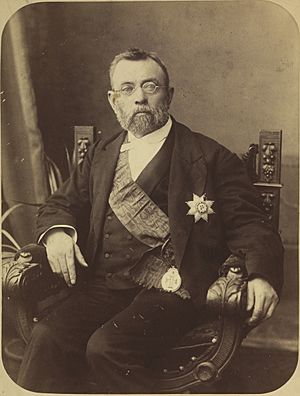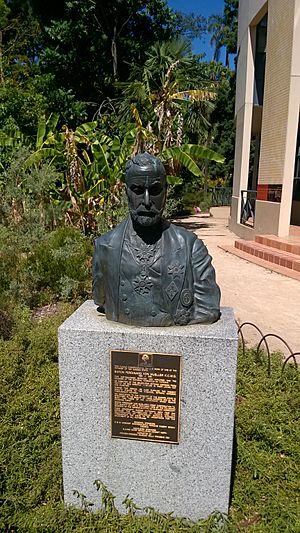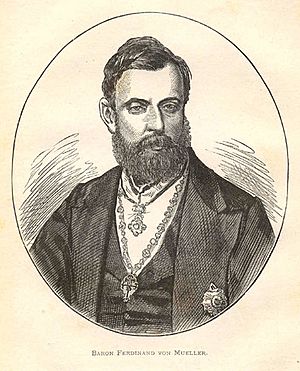Ferdinand von Mueller facts for kids
Quick facts for kids
Ferdinand von Mueller
|
|
|---|---|
 |
|
| Born | 30 June 1825 |
| Died | 10 October 1896 (aged 71) |
| Nationality | German-Australian |
| Citizenship | Naturalised British Subject in South Australia and Victoria |
| Awards | Clarke Medal (1883) Royal Medal (1888) |
| Scientific career | |
| Fields | botany, medicine, geography |
| Author abbrev. (botany) | F.Muell. |
Baron Sir Ferdinand Jacob Heinrich von Mueller (born 30 June 1825 – died 10 October 1896) was a famous German-Australian scientist. He was a physician (doctor), a geographer (someone who studies the Earth's features), and most importantly, a botanist (a plant scientist).
Ferdinand von Mueller became the government botanist for the Australian colony of Victoria (Australia) in 1853. He was later the director of the Royal Botanic Gardens, Melbourne. He also started the National Herbarium of Victoria, which is like a huge library of dried plant specimens. He gave names to many Australian plants that were new to science.
Contents
Early Life and Education
Ferdinand Mueller was born in Rostock, which is now part of Germany. Sadly, his parents, Frederick and Louisa, died when he was young. His grandparents made sure he received a good education in Tönning, Schleswig.
When he was 15, he started training to be a chemist. He passed his exams and then studied botany (the study of plants) at Kiel University. In 1847, he earned his PhD degree from Kiel. His special project was about the plants found in the southern parts of Schleswig.
Mueller's sister, Bertha, was advised to move to a warmer place for her health. A famous botanist, Ludwig Preiss, suggested Australia. So, in 1847, Ferdinand, Bertha, and their other sister Clara sailed from Bremen. Even on the ship, he was already studying plants! He reportedly fished his first plants out of the water to examine them.
Life in Australia
Ferdinand von Mueller was one of many important German-speaking people who came to Australia. These people brought their scientific knowledge and helped shape colonial Australia.
He arrived in Adelaide on 18 December 1847. He found work as a chemist there. But he loved to explore! He often walked alone to places like Mount Arden and Mount Brown in his first year. He even bought some land near Adelaide, planning to start a farm, but he soon went back to working as a chemist.
In 1851, Mueller moved to Melbourne, the capital of the new colony of Victoria. He thought about opening a chemist shop near the gold mines. He had already written some articles about plants for German magazines. In 1852, he sent a paper about "The Flora of South Australia" to a famous science group in London. This helped him become well-known among plant scientists.
Victoria's Government Botanist
Exploring Victoria's Plants (1853)
In 1853, Governor Charles La Trobe appointed Mueller as the government botanist for Victoria. This was a brand new job created just for him! He immediately started studying the plants of Victoria. He was especially interested in the plants growing in the mountains of Australia, which no one had really studied before.
He explored the Buffalo Ranges and traveled to the upper parts of the Goulburn River. He then crossed Gippsland to reach the coast. He explored areas like Port Albert and Wilsons Promontory. His journey covered about 1,500 miles (2,400 km) along the coast back to Melbourne.
In the same year, he started the National Herbarium of Victoria. You can still visit it today! It holds many plant specimens from Australia and other countries. Many of these were collected by Mueller himself. His large personal library was also given to the government of Victoria in 1865. It is now part of the herbarium's library in Melbourne.
Exploring Northern Australia (1855-1856)
Mueller was chosen to be the botanist for the North Australian Exploring Expedition (1855-1856). This trip was led by Augustus Gregory. Mueller explored the Victoria River and other parts of North Australia. He was one of four people who reached Termination Lake in 1856. He also traveled overland with Gregory's team to Moreton Bay.
During this expedition, Mueller discovered nearly 800 new plant species in Australia. One famous plant he found was Macadamia ternifolia, which he named after his friend, John Macadam. In this year, he also published his book Definitions of Rare or Hitherto Undescribed Australian Plants.
Scientific Leadership (1854-1872)
From 1854 to 1872, Mueller was a member of the Victorian Institute for the Advancement of Science. This group later became the Philosophical Institute of Victoria. He was the president of the Philosophical Institute in 1859. At that time, it received a special permission from the Queen and became the Royal Society of Victoria.
He was an active member of the society's "Exploration Committee." This committee planned the famous Burke and Wills expedition in 1860. Mueller strongly supported exploring Australia. He was one of only two members on the committee who had experience exploring. He gave many speeches to the society about the importance of exploration. He did not agree with choosing Burke as the leader of the expedition. However, because of disagreements within the committee, he had little say in how the expedition was set up or what supplies it took.

Leading the Botanic Gardens (1857-1873)
From 1857 to 1873, Mueller was the director of the Royal Botanic Gardens, Melbourne. He brought many new plants to Victoria. He also made the amazing qualities of the blue gum tree (Eucalyptus globulus) known around the world. He successfully introduced this tree to southern Europe, North and South Africa, California, and parts of South America.
Changes at the Gardens (1873)
By 1873, some important people in Melbourne felt that Mueller's way of running the Royal Botanic Gardens was too scientific. They wanted the gardens to be more beautiful and pleasing to look at. So, Mueller was removed from his position as director of the Botanic Gardens on 31 May 1873.
He had worked very hard to develop the gardens with the limited money he had. Even though his pay stayed the same and he continued as the government botanist, he was always sad about losing his director role.
In April 1873, Mueller had created a new plant group called Guilfoylia. He described William Guilfoyle as a "distinguished collector" who was very enthusiastic. Mueller had high hopes for Guilfoyle's plant collecting skills. However, Mueller's opinion changed when Guilfoyle was appointed to take his place as director of the Botanic Gardens in July 1873. Mueller said that Guilfoyle was just a "nurseryman" with no scientific knowledge. He also claimed Guilfoyle got the job because he was related to the minister's wife. Mueller later removed Guilfoylia from his plant list in 1882. Today, the genus Guilfoylia is accepted again. Guilfoyle went on to design the gardens in a beautiful way that most people in Melbourne loved.
Awards and Honors
In 1857, Mueller was given a Doctor of Medicine degree from the University of Rostock. In 1883, he received the Clarke Medal from the Royal Society of New South Wales.
Many countries honored Mueller, including Germany, France, Spain, Denmark, and Portugal. He became a member of the Royal Society in 1861. He was also knighted as Knight Commander of the Order of St Michael and St George in 1879. He received many of his awards for sending animal specimens to royal museums.
He helped the explorer Ernest Giles. Giles visited Lake Amadeus and Kata Tjuta (also known as Mount Olga). Giles originally wanted to name these places Lake Mueller and Mount Ferdinand. But Mueller convinced Giles to name them Lake Amadeus, after King Amadeus of Spain, and Mount Olga, after Queen Olga of Württemberg. Both kings had given Mueller honors. In 1871, King Karl of Württemberg gave him the special title of Freiherr (Baron). This was to recognize his great work in natural sciences. After this, he was known as Baron Sir Ferdinand von Mueller.
Death
Ferdinand von Mueller died in Melbourne and is buried in the St Kilda Cemetery. His sister, Mrs. Clara Wehl, who lived in Millicent, South Australia, survived him. His other sister, Mrs. Bertha Doughty, had passed away before him. He never married.
Scientific Ideas
Mueller believed in a creator and had different ideas about how life evolved compared to Charles Darwin. However, despite their differences, he remained good friends with Darwin.
Standard Author Abbreviation
Legacy
The Mueller Medal has been given out since 1904 by the Australian and New Zealand Association for the Advancement of Science. It is awarded to a scientist who has made important contributions to the study of people, plants, geology, or animals, especially in Australia.
A Victorian Railways diesel train, S311, is named after Mueller.
Places Named After Mueller
Many places are named after Ferdinand von Mueller:
- The Mueller Ranges in Western Australia
- Muellers Range in Queensland
- Mount Mueller (in WA, Northern Territory, Tasmania and Victoria)
- Mount von Mueller (WA)
- Muellers Peak in New South Wales
- The Mueller River in New Zealand
- Muellers Creek in South Australia
- Mueller Creek in the Northern Territory
- Lake Mueller in Queensland
- Mueller hut near the Mueller Glacier in New Zealand
- Mueller Park, Subiaco (WA)
Artworks About Mueller
- Love, Death, Music and Plants is a music theatre show based on parts of Mueller's life. It was written by Brian Lipson and Matthew Hindson. It was performed at the Mueller Hall, National Herbarium of Victoria, in November 2003.
- A statue (bust) of Mueller by Marc Clark is located outside the National Herbarium of Victoria.
Plants Named After Mueller
Many plant species are named to honor Mueller. Their names usually end in muelleri, muellerina, or muelleriana. Some examples include:
- The plant group Muellerina
- Callitris muelleri
- Persoonia muelleri
- Verticordia muelleriana
- Allocasuarina muelleriana
- Eucalyptus muelleriana
- Terminalia ferdinandiana
Animals Named After Mueller
An Australian lizard species, Lerista muelleri, is named in his honor. Several fish and invertebrates (animals without backbones) are also named after him.
See Also
- List of Australian plant species authored by Ferdinand von Mueller
- Systematic Census of Australian Plants
- Burke and Wills expedition
- Cape Leeuwin Wattle
- Tietkens expedition of 1889
- Category:Taxa named by Ferdinand von Mueller
Additional Publications Online
- Index perfectus ad Caroli Linnaei : species plantarum / collatore Ferdinando de Mueller. (1880)
- Eucalyptographia. A descriptive atlas of the eucalypts of Australia and the adjoining islands (1879–1884)
- Iconography of Australian species of Acacia and cognate genera (1887)
- Select extra-tropical plants readily eligible for industrial culture or naturalisation (1891)
- Introduction to botanic teachings at the schools of Victoria (1877)
- The organic constituents of plants and vegetable substances and their chemical analysis (1878)
- Manuel de l'acclimateur (1887)
- Fragmenta phytographiæ Australiæ /contulit Ferdinandus Mueller (1858–1882)
- The plants indigenous to the colony of Victoria, Volume 1 (1860–1862)
- Key to the system of Victorian plants (1887/88)
- The Vegetation of the Chatham Islands (1864)
- Iconography of Salsolaceous plants (1889) R.S. Brain Government Printer, Melbourne.



